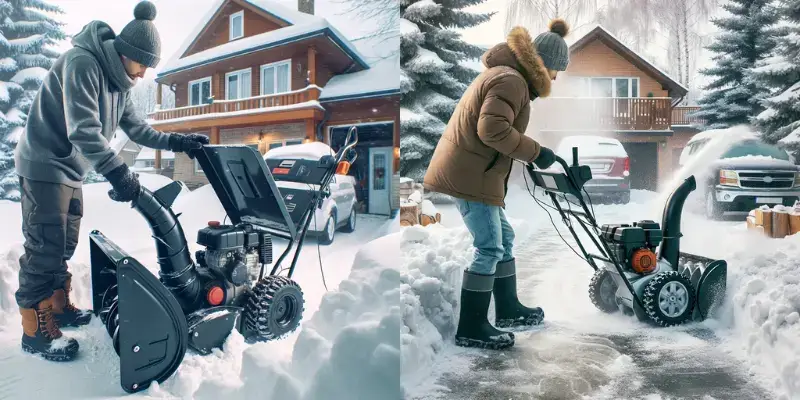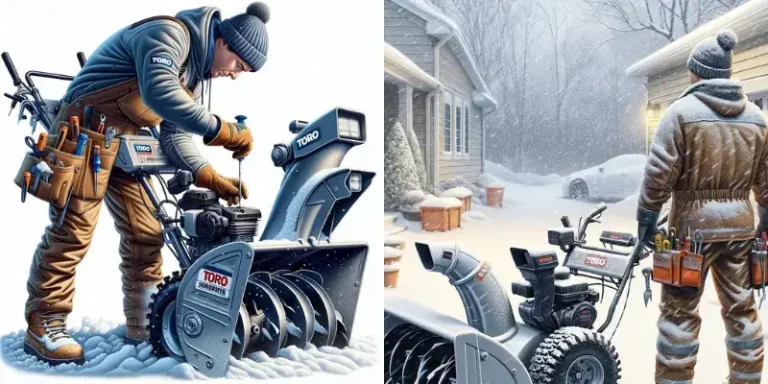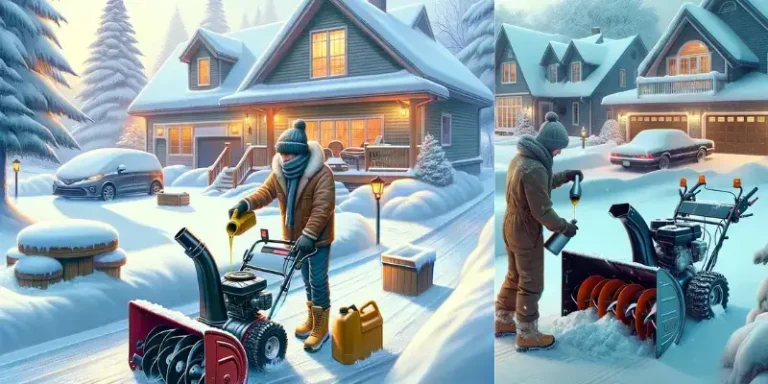Can a Snow Blower Overheat? Troubleshooting & Preventions
Winter brings the inevitable task of snow removal, and snow blowers are the go-to solution for many. These powerful machines efficiently clear snow, making winter life easier. But an important question arises: Can snow blowers overheat?
In this blog, I am going to discuss the important issues and explore the reasons behind overheating, its impact on snow blower performance, and the essential steps to prevent and address this problem. Understanding these aspects is vital for maintaining the long life and effectiveness of your snow blower.
Understanding Why Snow Blowers Overheat
Snow blowers, those essential winter tools, are not immune to the frustrating issue of overheating. While this problem might seem surprising given the cold environment in which these machines operate, there are several key reasons why your snow blower might be getting a bit too hot under the hood.
Key Factors Leading to Snow Blower Overheating
Overheating in snow blowers is not just a possibility; it’s an occurrence that can be attributed to several factors:
Spark Plug Dilemmas:
A worn or dirty spark plug strains the engine, leading to overheating. Regular checks can prevent this issue.
Armature Issues:
A malfunctioning armature in the motor can cause significant overheating, demanding immediate attention.
Valve Lash Troubles:
Incorrect valve lash adjustment can cause inefficient engine functioning, increasing the risk of overheating.
Gas Cap Glitches:
A non-venting gas cap creates a vacuum, forcing the engine to overwork and overheat.
Real-world instances and Expert Insights on Overheating
“Mechanics often cite these factors when tackling overheating issues in snow blowers. For example, a service report might highlight a corroded spark plug as the culprit behind a recent overheating incident.”
Diagnosing Overheating in Snow Blowers
It’s not uncommon to encounter overheating issues with snow blowers, especially during heavy use. Overheating can lead to significant damage if not addressed promptly. Understanding the symptoms and knowing how to diagnose the problem is crucial in maintaining the health of your snow blower.
Spotting the Symptoms of an Overheating Snow Blower
Recognizing overheating early is key to preventing damage. Look out for:
Sudden Power Loss:
A struggling or stalling engine is a major indicator.
Unusual Smoke:
Excess smoke points towards overheating.
Engine Noises:
Knocking sounds are a tell-tale sign of an overheating engine.
Inefficiency in Operation:
A noticeable drop in performance suggests overheating.
Step-by-Step Diagnosis of Overheating Issues in Snow Blower
Let’s break down the process of diagnosing overheating issues in a snow blower into easy-to-follow steps. Whether you’re a seasoned snow blower enthusiast or a novice, these steps will help you identify and address the problem like a pro.
Step 1: Spark Plug Inspection
Start by inspecting the spark plug. Look closely for any damage or signs of wear. A worn-out spark plug can lead to poor combustion, causing your snow blower to overheat. If you see any issues, it’s time for a replacement.
Step 2: Armature Examination
Next up, take a careful look at the armature. This crucial component can malfunction, causing your snow blower to overheat. Look for any visible signs of damage, corrosion, or loose connections. If you spot any problems, you may need to repair or replace the armature.
Step 3: Check Valve Lash Adjustment
Valve lash adjustment is often overlooked but can significantly impact your snow blower’s performance. Improper valve lash can cause overheating. Use a feeler gauge to check and adjust the valve lash according to your snow blower’s specifications. This simple step can make a big difference.
Step 4: Gas Cap Vent Inspection
A clogged or malfunctioning gas cap vent can create a vacuum inside the fuel tank, restricting fuel flow and causing overheating. Ensure that your gas cap is venting properly. Clean or replace it if needed to maintain proper airflow.
Step 5: Essential Diagnostic Tools
To perform these diagnostics effectively, consider using some handy tools. A multimeter will help you check electrical components for continuity and proper functioning. A feeler gauge is essential for precise valve lash adjustment. These tools can save you time and ensure accurate assessments.
By following these step-by-step instructions and performing these checks, you’ll be well on your way to diagnosing and addressing overheating issues in your snow blower. Keeping your snow blower in top condition ensures that it’s always ready to tackle the winter weather, making your life a whole lot easier when the snow starts falling.
Solving and Preventing Overheating Problems in Snowblower
Effective Solutions for Overheating Issues in Snow Blowers
Are you facing overheating problems with your trusty snow blower? Fret not, we’ve got you covered with some effective solutions to get your machine back in top-notch condition.
Replacing the Spark Plug:
Overheating can often be traced back to a worn-out or damaged spark plug. Swapping it out for a new one can work wonders and is a quick fix to consider.
Fixing the Armature:
If your snow blower’s armature is acting up, it may need some TLC. Repairing or replacing this vital component can put an end to overheating troubles.
Adjusting Valve Lash:
Don’t underestimate the importance of proper valve lash adjustment. It ensures that your engine runs smoothly and doesn’t overheat. Invest in a feeler gauge to get it just right.
Replacing the Gas Cap:
A seemingly small issue like a malfunctioning gas cap can cause overheating by disrupting engine ventilation. Make sure your gas cap is doing its job to keep things cool.
Proactive Steps to Prevent Snow Blower Overheating
Prevention is indeed the best medicine. To keep your snow blower running smoothly and prevent overheating in the first place, consider these proactive measures:
Use Fresh, Stabilized Gasoline:
Your snow blower deserves the best fuel. Opt for fresh gasoline with a stabilizer to keep the engine humming happily.
Regular Engine Maintenance:
Don’t wait for problems to snowball. Regular maintenance checks can catch potential issues early, preventing overheating and ensuring peak performance.
Proper Storage:
When the snow season ends, store your snow blower in a dry, clean place. Moisture and dirt can lead to rust and engine strain, causing overheating down the line.
By following these effective solutions and proactive steps, you’ll not only resolve overheating problems in your snow blower but also keep it in tip-top shape for many snowy seasons to come
FREQUENTLY ASK QUESTIONS (FAQs)
Can a snow blower overheat?
Yes, a snow blower can overheat, especially when it is not properly tuned or when it is running in heavy snow and ice conditions. It can also happen if the snow blower is running for an extended period without stopping.
What can cause a snow blower to overheat?
Overheating in a snow blower can occur due to running it with debris or leaves in the snow, running it in heavy snow and ice conditions, or if the engine is not properly tuned.
How can I prevent my snow blower from overheating?
To prevent a snow blower from overheating, ensure that the area is clear of debris and leaves before use, have the snow blower properly tuned, and if the engine is running lean, adjust the carburetor to the suitable settings.
Why does my snow blower stop when it overheats?
When a snow blower overheats, it may stop running to prevent further damage to the engine or components. It’s a safety feature designed to protect the equipment from damage.
What type of snow blowers are more prone to overheating?
Older snow blowers and those that are not designed to handle heavy snow and ice conditions are more prone to overheating, especially if not properly maintained.
How long should I run a snow blower before letting it rest to avoid overheating?
It’s recommended to give the snow blower a rest if it has been running for an extended period, typically after 1-2 hours of continuous use, to avoid overheating.
Can leaving a snow blower outside in extreme weather conditions hinder its performance and cause it to overheat?
Yes, leaving a snow blower outside in extreme weather conditions, especially in very low temperatures, can cause the engine to struggle and overheat when trying to start it up if the tank is not empty and properly maintained.
What should I do if my snow blower overheats?
If your snow blower overheats, immediately turn it off, let it cool down, remove any snow or ice buildup, and check for any debris obstructing the machine. Once it cools down, you can restart it after ensuring everything is back in place.
Will using a snow blower in areas with grass or gravel cause it to overheat?
Using a snow blower in areas with grass or gravel should not cause it to overheat if it is being used as per the manufacturer’s design. However, it’s essential to be cautious and avoid any major obstacles that can hinder the snow blower’s performance.
What kind of maintenance should I perform on my snow blower to prevent it from overheating?
Proper maintenance includes regularly checking and cleaning the machine, lubricating moving parts, and ensuring all settings, such as the carburetor and feeler gauge, are suitable for optimal performance, which helps prevent overheating.
Conclusion:
In conclusion, snow blowers can indeed overheat, but with the right knowledge and maintenance practices, this issue can be effectively managed. Being proactive in understanding the causes, symptoms, and solutions for overheating is key to ensuring your snow blower remains a reliable tool throughout the winter season.

About Naveed A Hashmi
In my childhood, I used to see my parents while working in the land, for these reasons today I have been serving the same as our own tradition and culture. I thus love to stay in it, because I want to learn something advanced and new so that I may improve my farm’s contour and help others with my experience.







